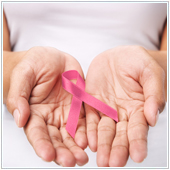 Breast cancer is the most common type of cancer among women, aside from skin cancer. According to HealthFinder.gov, 1 in 8 women in the U.S. will get breast cancer at some point in her life.
Breast cancer is the most common type of cancer among women, aside from skin cancer. According to HealthFinder.gov, 1 in 8 women in the U.S. will get breast cancer at some point in her life.
The good news is that with early detection and treatment, most women can survive breast cancer. October is a month dedicated to raising awareness about the importance of screening and early detection of breast cancer. The more women that are aware of the risks and preventative steps they can take, the more lives can be saved. In fact, NationalBreastCancer.org reports a 98% survival rate when breast cancer is detected early.
Here are 3 steps that should be taken to detect and prevent breast cancer.
#1: Take all possible measures to lower your risk
While cancer cannot be prevented, there are some things you can do to reduce your risk, including:
-
Limit your alcohol consumption
-
Refrain from smoking
-
Eat healthy foods (i.e. fruits and vegetables)
-
Stay physically active and maintain a healthy weight
#2: Know the signs & symptoms
In most cases, noticing one of these symptoms does not mean you have cancer, but you should still see a healthcare professional immediately. There are 3 particular things to look for:
-
Changes in how the breast or nipple feels: new tenderness or a lump, a change in texture or an increase in pore size
-
Changes in how the breast or nipple appears: a difference in size, shape or skin texture
-
Any nipple discharge
#3: Early detection is key
Performing monthly breast self-exams will help you identify any changes or abnormalities. Johns Hopkins Medicine states, “Forty percent of diagnosed breast cancers are detected by women who feel a lump, so establishing a regular breast self-exam is very important.”
Once you are aware of the signs and symptoms to look for, taking steps to screen yourself should be simple.
-
Conduct a monthly self-exam
-
Get an annual clinical breast exam
-
Women 40 and older should get mammograms every 1-2 years
It’s important to note that breast cancer is not limited to women. 2,190 men are diagnosed with breast cancer each year. Due to a lack of awareness, the mortality rates are higher among men. You can help by spreading the word about prevention and early detection to your loved ones. As always, we are here to answer any questions you may have. Call [phone_main] to speak with a healthcare professional today.
 Heart disease is a scary thing. In fact, it’s the leading
Heart disease is a scary thing. In fact, it’s the leading 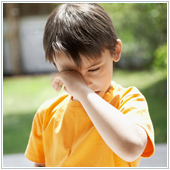 We all get an eyelash in our eye from time to time, causing a little discomfort and a momentary concern for a parent, but it’s nothing compared to the redness and swelling that comes from pinkeye. Formally known as Conjunctivitis, pinkeye is a common concern for school nurses and the parents of school-aged children alike.
We all get an eyelash in our eye from time to time, causing a little discomfort and a momentary concern for a parent, but it’s nothing compared to the redness and swelling that comes from pinkeye. Formally known as Conjunctivitis, pinkeye is a common concern for school nurses and the parents of school-aged children alike.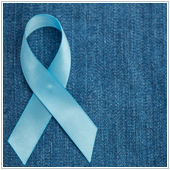 As we welcome back changing leaves and the daily sight of school busses on the road, we also begin a month designated to celebrate the prolonged lives of men, thanks to Prostate Cancer Awareness Month. This September is not only a time to celebrate the return of football season, but also a time to discuss prostate health.
As we welcome back changing leaves and the daily sight of school busses on the road, we also begin a month designated to celebrate the prolonged lives of men, thanks to Prostate Cancer Awareness Month. This September is not only a time to celebrate the return of football season, but also a time to discuss prostate health. Whether it’s a light hum, a loud choke or an ongoing rattling and snorting sound, snoring can be a major annoyance for both the snorer and anyone nearby. According to the
Whether it’s a light hum, a loud choke or an ongoing rattling and snorting sound, snoring can be a major annoyance for both the snorer and anyone nearby. According to the  Many of us love to travel, but not every aspect of a travel adventure is fun and games. From lost luggage to a sunburn, there can be little annoyances along the way, but the enjoyment of seeing a new place usually outweighs the hassles. With summer coming to a close, there’s no better time to learn a little bit about one of the most pesky side effects of travel – jet lag!
Many of us love to travel, but not every aspect of a travel adventure is fun and games. From lost luggage to a sunburn, there can be little annoyances along the way, but the enjoyment of seeing a new place usually outweighs the hassles. With summer coming to a close, there’s no better time to learn a little bit about one of the most pesky side effects of travel – jet lag!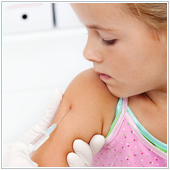 Maybe it’s still hot outside, but the truth is that summer is beginning to wind down and it’s time to start thinking about a new school year. Notebooks, backpacks, pencils and clothing are all important, but what’s even more important is your child’s health. There are many things you can do to prepare for a new school year and keeping up with vaccines that can stop serious diseases and illnesses in their tracks should be at the top of your list.
Maybe it’s still hot outside, but the truth is that summer is beginning to wind down and it’s time to start thinking about a new school year. Notebooks, backpacks, pencils and clothing are all important, but what’s even more important is your child’s health. There are many things you can do to prepare for a new school year and keeping up with vaccines that can stop serious diseases and illnesses in their tracks should be at the top of your list.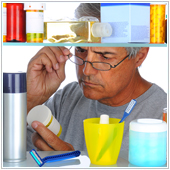 Knowing how to properly store your medication may sound like a common sense concept, but the importance of properly storing your medication can make a huge difference in it’s effectiveness and in the safety of those around you.
Knowing how to properly store your medication may sound like a common sense concept, but the importance of properly storing your medication can make a huge difference in it’s effectiveness and in the safety of those around you. Our grandparents love it. Babies and teenagers get a lot of it. So, what’s holding us all back from enjoying some extra sleep? Even if you’re one who loves your sleep and understands why it’s so important, it all comes down to precious time. We lose an hour or two for a morning run and we get to bed a little later when a new show is on TV. Getting enough sleep is a constant battle. Obligations at work and home are priority, so you keep plugging away until you can’t keep your eyes open anymore.
Our grandparents love it. Babies and teenagers get a lot of it. So, what’s holding us all back from enjoying some extra sleep? Even if you’re one who loves your sleep and understands why it’s so important, it all comes down to precious time. We lose an hour or two for a morning run and we get to bed a little later when a new show is on TV. Getting enough sleep is a constant battle. Obligations at work and home are priority, so you keep plugging away until you can’t keep your eyes open anymore. We’ve all heard of lice, your family has even probably had a scare or two. Of the three variations of lice – head lice, body lice and public lice – head lice is the most common. Furthermore, according to a
We’ve all heard of lice, your family has even probably had a scare or two. Of the three variations of lice – head lice, body lice and public lice – head lice is the most common. Furthermore, according to a